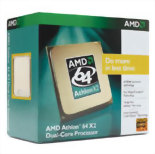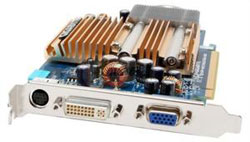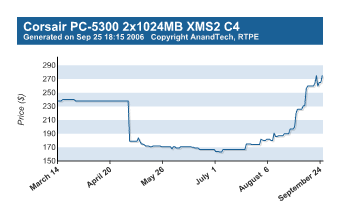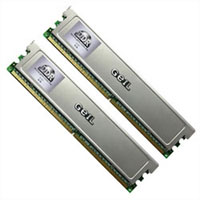Baseline AMD Midrange Platform
For several years, virtually every single one of our buyer's guides has come out with the statement that AMD is the preferred platform for price/performance over Intel. This was simply a matter of choosing the best platform, which has been AMD's K8 processor architecture for about three years. Unfortunately for AMD proponents, this is no longer the case. Simply put, Intel has crushed one out of the ballpark with the launch of the Core 2 platform. If you are looking for faster processor performance, with very few exceptions Intel now holds the lead. The good news is that the AMD platform still has a couple points in its favor. We will get into those shortly, but let's start with the baseline AMD recommendations.
 |
With prices being what they are, there's absolutely no reason to consider anything other than a dual core processor these days for a midrange computer. Not everyone is going to make full use of both processor cores, but even in everyday computer use the dual core systems feel more responsive and multitask better, and we only expect the gap between single core and multi-core configurations to widen in the future. That doesn't mean you need to go out and purchase the fastest dual core processor you can find, and in fact we have gone with the slowest Athlon X2 currently available, the 3800+ for socket AM2. Clocked at 2.0 GHz and sporting 512K of L2 cache, the 3800+ used to cost over $300 just a few months ago. With the price now cut in half, there's a whole lot to like. Overclocking capabilities are still good, and it should be pretty easy to run the 3800+ at 2.5 GHz if that's what you're after. Most people don't run a lot of CPU limited applications, so upgrading to a faster processor shouldn't be your first move unless you specifically run tasks that will benefit.
 |
The biggest advantage of the AM2 platform is undoubtedly in the area of motherboards. Prices are so low on reasonable motherboards that we feel there is little reason to get anything other than a board that supports either SLI or CrossFire, at least in the midrange price segment. You may not need the second X16 slot initially, and perhaps it will never get used, but the cost of adding the second slot is only about $20, and you often get better features along with the additional PEG slot. We feel the best overall choice for midrange AM2 motherboards is the nForce 570 SLI chipset. Performance nearly matches the more expensive nForce 590 SLI offerings but at a significantly lower price. Doubling the PCI-E bandwidth sounds good in theory, but the reality is that very few tasks are truly bandwidth starved from the PCI-E bus.
Having decided on a chipset, the overwhelming favorite motherboard using this chipset would be the EPoX 570 SLI. If you can find one in stock at a reasonable price, that would be our primary choice, but at present most online retailers are on back order. A very good alternative is the MSI 570 K9N SLI Platinum, which still overclocks reasonably well. It also costs less than the EPoX board and it comes with FireWire support. The Northbridge heatsink can get quite hot without some form of active cooling nearby, but in a properly ventilated case with a typical CPU HSF, it shouldn't present any problems.
The one area that is an absolute shock after the last midrange guide is the choice of DDR2 memory. A few months ago, it was possible to find 2x1024MB of reasonable quality DDR2 memory for under $150. At present, prices are up over $50 across the board. The situation is illustrated nicely by this price graph of the Corsair PC2-5300 C4 memory. If you browse through the DDR2 section of our
Real Time Price Engine, you will see this same type of graph again and again. Unfortunately, all we can do for now is hope that prices will drop, but anyone looking to purchase memory right now will simply have to bite the bullet. Thankfully, the GEIL PC-5300 2x1024MB Value memory that we selected performs very well. While it is rated at DDR2-667 5-5-5-15, we have found in testing that it will run at 4-4-4-10 with 1.95V at DDR2-667, 4-4-4-12 at DDR2-800 with 2.1V, and 5-5-5-15 at DDR2-900 with 2.3V. The integrated memory controller of the AM2 platform makes memory bandwidth less of a concern, but it is still nice to get memory that can run at DDR2-800 if you want to do some overclocking.
 |
Choosing a good midrange video card really isn't too difficult, provided you know the intended use. For our baseline midrange configuration, we are going off the assumption that gaming isn't a primary concern. Taking a quick look at the $100-$125 GPU market, the NVIDIA GeForce 7600 GS comes out as the overall best performance and value. More importantly, the Gigabyte card received our editor's choice in the
silent GPU roundup last month. This card consistently outperformed the other silent offerings, and it even manages to do so at a lower price than many of its direct competitors. Windows Vista will make GPUs more important for general use, so we don't feel that any new midrange system should go any lower than the 7600 GS. And even if we say that gaming isn't a primary concern, the 7600 GS is still able to handle most current games at moderate detail settings.
We will leave discussion of the remaining baseline component choices for the next page where we cover the Intel baseline platform, as the only difference between our AMD and Intel choices are in the motherboard and processor departments. If you're looking for other alternatives, however, we do have a few suggestions.
We already mentioned the Epox 570 SLI motherboard, but if you are absolutely certain you don't want the second X16 PCI-E slot, the DFI Infinity NF4 Ultra2-M2 is getting a great reputation as an overclocking king and it is $95 now. It is based on the nForce4 chipset but it still works with socket AM2. Really, the difference in performance between nForce4 and nForce 5 is negligible for most applications, and the DFI Ultra2-M2 is absolutely rock solid when it comes to stability.
Alternatives for the memory are easy to find, although we would stick with DDR2-667 or faster memory. All of the major manufacturers have reasonable products, and right now price is going to be a in determining which RAM to buy. A-DATA, Corsair, Crucial, G.Skill, Kingston, OCZ, PDP, PQI, and others are worth considering, and you might also want to check out the
Value DDR2 section of the Conroe Buying Guide for more information. Gamers will probably want a faster graphics card, and we recommend looking at our upgraded configuration for more information on faster graphics cards. What about 2x512MB of RAM instead of the full 2GB? Windows Vista is really going to tax 1GB systems, and we feel strongly that any midrange PC should be viable without upgrades for at least the next year. We feel you are truly going to regret going with anything less than 2GB of memory in the near future, and we only recommend 1GB configurations for entry level computing these days.
















49 Comments
View All Comments
JarredWalton - Tuesday, September 26, 2006 - link
Caps are often one of the most critical factors in overclocking. Obviously, the difference isn't huge, and neither is the difference in price (about $20 more for the DS3). "A bit better" means that you will really have to be pushing hard to reach that point; RAM is likely to give out before either motherboard.RamarC - Tuesday, September 26, 2006 - link
IMHO, the upgraded Intel config can be improved quite a bit for $82 more ($37 more w/available rebates). I'd move up to an E6600, select ASUS P5B-E mobo, and use dual hard drives in matrixRAID. An Antec Sonata II w/450W PS would be subbed in for the case. This config will be plenty fast in 'stock' form and still has some OC headroom.Core2Duo E6600 . . . . . 319
ASUS P5B-E . . . . . . . 164
OCZ 2GB Gold Gamer DDR2-800 . 260
GeForce 7900GS
or Radeon x1900gt . . .. 206
2 WD 1600JS 160GB . . . . 124
LiteOn 165H6S retail . . . 42
Acer AL2216WBD 22" WS . . . 337
Antec Sonata II w/450W PS . 110
Logitech Premium . . . . 30
Windows XP MCE . . . . . 120
Total . . . . . . . . .. . $1,712
rjm55 - Tuesday, September 26, 2006 - link
I'm in total ageement with your idea. I was more than a little surprised to see the lowest 2MB cache Core 2 Duo as the choice in the first Intel, but I figured it would be fixed in the the upgrade choice with a 4MB cache model. It wasn't. The 4MB cache does make a performance diffence and is always faster at the same speed. I would pick a E6600 for my own midrange system.I would also choose a lowend 975 for the true dual x8 Crossfire. Abit has a decent 975 board for $159. This would actually be $5 less than your setup with a 965 board.
JarredWalton - Wednesday, September 27, 2006 - link
I added some clarification on the "upgraded" Core 2 page for you guys. :)Basically, your selections are perfectly acceptable alternatives, but if I were to put up my upgraded build with overclocking agains your upgraded builds, I would wager I can get better overall performance. Not everyone wants to overclock, and that's fine, but my picks were made with a bit more of an overclocking bias.
The $260 OCZ DDR2-800 doesn't OC very well at all, while the $280 RAM does much better. In fact, the $260 RAM you link has had some compatibility issues with some motherboards (it wants to POST with higher voltages for the listed timings, IIRC), so you would be better off getting the $220 OCZ DDR2-667 in my book.
The bottom line is that you have to determine what you want to do with the PC. For gaming (you mention CrossFire), spend a lot of money on the GPUs before you even worry about upgrading the CPU (unless you run games at 1024x768). If you plan on running X1900 CrossFire, though, you really better think about upgrading to a nice PSU like the Fotron Source listed. For X1900 XT CrossFire (or X1950 CF), you should probably go with a Fotron Source 700W (or OCZ GameXStream, Thermaltake 700W, or several others which are just rebranded FSP units).
JarredWalton - Tuesday, September 26, 2006 - link
I unfortunately have to say that Antec PSUs have gone way downhill in the past year. Ask Gary how many dead Antec units he has sitting around. Other than that, though, you demonstrate exactly what I tried to point out: there are a ton of different ways to attack a midrange build, especially at the $1500-$1700 price point. We went with better RAM and a much better PSU with a lower end CPU. RAID won't really help performance much IMO (unless you want RAID 1 for redundancy), and I would rather have a single drive instead of two drives for the same amount of storage (cheaper too).As for the CPU, the E6600 is definitely faster. With overclocking, it's lot closer, as the 2MB cache Core 2 Duos will generally overclock further than the 4MB cache CPUs. At that point, you have to decide whether you really need faster CPU performance or if you should improve something else. If you play games as your primary focus, even the X2 3800+ will be essentially tied with the E6600 until you start to get into much faster GPUs.
RamarC - Tuesday, September 26, 2006 - link
I'm a big fan of MatrixRaid. Dual 160s can be config'd as a 40gb mirror (boot, OS, important docs, etc.), and a 220gb strips set (game files, mp3s, dvd rips, page file, temp folder, etc.). A bit more expensive than a single drive, but a more performance and much safer.You guys obviously go through PSs more than me. Still, I'd rather spend about the same cash and get a faster stock system than one that I have to OC to reach the same level of performance.
Araemo - Tuesday, September 26, 2006 - link
I didn't see any discussion of it in the article, but which of those monitors are 24 bit(8 bit panels)?I'm rather picky about colors, and I wouldn't consider any 6 bit panels. I've seen 8 bit panels with good enough refresh times(Using overdrive) from some companies, but it can be such a PITA to find out for sure if a given monitor uses a panel that is 8 bit or 6 bit, that I would like to see that kind of information noted when a recommendation is being made...
Super Nade - Tuesday, September 26, 2006 - link
Hi,I have serious issues regarding the PSU's being recommended. Why are you guys skimping on a no-name, possibly dodgy PSU? To keep things in budget, I'd suggest cutting back on the case and the DRAM, possibly substituting a 17 inch display for the 19 inch. There are several good reasonably priced PSU's (say $80 range)available.
I like the article and agree with most of the recommendations, but for the PSU :)
Regards,
S-N
Revolutionary - Wednesday, September 27, 2006 - link
Everybody questioning the choice of a Fortron-Source PSU because they "have not heard of them" needs to get a clue.They MAKE power-supplies as an ODM. Often the Antec, Enermax, whatever-pricey-name-brand-you-want-to-insert PSU is just a re-badged FS model.
And if you check out the "cool-n-quiet" community, you will find that FSP actually has quite a following. I've personally used 3 of their PSUs (I'm still using one, actually: a 300W 120mm fan model that I bought about 3 years ago...).
Mass marketing brand awareness does not a good component make.
Gary Key - Tuesday, September 26, 2006 - link
While I am one to usually advocate buying a 700W or above power supply for any system ;-> , we looked at the baseline system requirements and determined the included power supply from Gigabyte was adequate to meet the systems needs. There are numerous case/power supply choices in this range and most of the tier one case suppliers provide decent power supplies. I for one like the Cooler Master Centurion 5 combo with their 380w power supply for a base system. Obviously, if you designed a system around the base configuration and wanted to overclock your system (in the case of the AMD unit, also run SLI) then a better power supply is certainly warranted.In the upgraded configuration I think our power supply choice reflected one of the best price/performance choices in the 500W~600W range. There was another FPS 550W power supply that was actually at the top of our list for a couple of more dollars but it was sold out at the majority of on-line stores.
:)